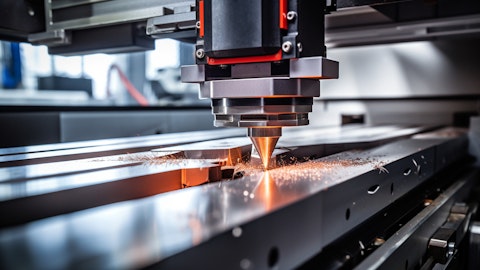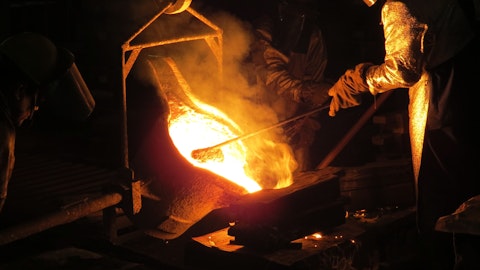Bill Peterson: I guess if we think about – yes, good morning. You mentioned some of the end markets remain soft, but you also commented about the weather conditions for Muscle Shoals. I guess for the latter, can you quantify the impact in terms of maybe quarter-on-quarter or year-on-year comparison? And I guess, if it is down for a week, that would kind of imply sort of a high single-digit type of shipment loss, but I’m not sure if that’s the right way to think about it. And then just really trying to understand just the near-term demand drivers impacting the first quarter. If you can kind of help us understand by end market, what you’re seeing and maybe even including commenting by region.
Jean-Marc Germain: Yes. So Bill, on the impact, I mean, I think it will all depend of the Muscle Shoals situation in Q1. It will all depend on how much ground we can make up and all that. So in the quarter it’s not over. But I think in terms of misshipments, you’re absolutely right. The plant is at a stand still for a week. So – and it’s supposed to be a week where you produce your easily in the 10kt range. So the market conditions we’re seeing right now. So we’re seeing can strong in North America, a little bit weak still in Europe, but better than it has been. We are seeing the aerospace market very good in Q1. And in terms of auto, there’s a divergence between North America and Europe. Europe is slow and North America is extremely strong to the point that we are challenged to make everything we need to make in North America.
And finally, on specialties, we don’t see yet a rebound. But we’re seeing a few green shoots here and there. Some customers are being a little bit more optimistic, but it’s – that’s why we think the market may turn this year, but we are not seeing really tangible massive evidence of that just yet. Did I answer your question?
Bill Peterson: Yes. No, that’s very helpful. Maybe in terms of capital allocation, it’s great to see the leverage where it is and of course, the announced buyback and realizing you have the May – meeting to define how that can look further. But I guess holistically, would you think of this – would you want to put this in a way to be sort of like a payout ratio, a percentage of free cash flow or opportunistic if you were to think about this in the second half of the year and beyond?
Jean-Marc Germain: Yes. So Bill, I think the way we look at the capital allocation is fundamentally, we want a balanced capital allocation. We are committed to this $300 million share repurchase program through the end of 2026. How exactly it unfolds, still to be determined. But as I said, we will update you on a quarterly basis. We think it’s – we look at it in the – from the viewpoint of we want to have good returns on every capital allocation we make. We want it to be balanced so that there’s a balance between returning money to shareholders, continuing to invest in the business, building the financial flexibility. And over time, if you – which I’m sure you do, you run the numbers, you will see that the company, even though at a $300 million free cash flow – sorry, share repurchase buyback, the company continues to delever.
And we certainly don’t – we want to stay within our 1.5x to 2.5x range. So as we do that, we’re building flexibility and over time, that shareholder return program will certainly continue. Jack, anything you want to add?
Jack Guo: Yes. I mean, Bill, the only thing I would add is I don’t – we don’t want to be too prescriptive we want to – in terms of like a ratio per se, I think we want to maintain some of the flexibility. It’s the first time we are executing a share buyback program. It will – from an execution perspective, will be quite hands off and leverage the 10b5 program.
Bill Peterson: Okay. If I could sneak in one more. So I guess if you think about the broader scrap market in the U.S. and Europe, I guess we’re wondering, is there – do you think there’s sufficient supply to meet the growing demand needs, especially with two new rolling mills ramping in the U.S?
Jean-Marc Germain: Yes, definitely. So I think the rolling mills are ramping up later in the decade as you know. The market continues to grow. There is more aluminum being used, and therefore, more aluminum being recycled naturally. And then with the focus on more of a circular economy, one should expect that also the recycle rate is going to improve. So yes, we believe there is ample supply of scrap. And by the way, both Europe and North America are today exporting a significant amount of scraps to Asia, which is a bit of a waste. And if we can find a more economical way to recycle the scrap domestically, then obviously, that’s addressing a problem and finding a profitable solution for a problem that exists today, which is this leakage of scrap to faraway countries. So yes, I think we’re in very good shape for this decade at least.
Bill Peterson: Okay. Thanks for the insights and I’ll pass on. Congrats on the execution.
Jean-Marc Germain: Thank you.
Operator: We now turn to Curt Woodworth with UBS. Your line is open. Please go ahead.
Curt Woodworth: Yes. Thank you. Good morning, Jean-Marc. Question on P&ARP. So if we look at EBITDA per ton this quarter at €345, that’s the highest we’ve seen in many years despite volumes being the lowest that you’ve had all year. So can you kind of comment on, I guess, margin expectation for that business going forward? How you see net price into 2024?





